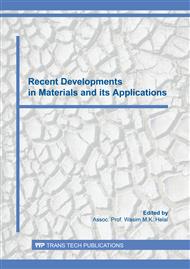[1]
U. SYilmaza and H. Turken, The effects of various curing materials on the compressive strength characteristic of the concretes produced with multiple chemical admixtures Scientia Iranica A 19 (2012), 77–83.
DOI: 10.1016/j.scient.2011.11.038
Google Scholar
[2]
V. Penttala. Concrete and sustainable development, ACI Materials Journal, (1997) 409– 416.
Google Scholar
[3]
Z. Li, Advanced Concrete Technology, John Wiley & Sons, Inc., Hobo-ken, New Jersey, (2011).
Google Scholar
[4]
O. M Olofinnade, J.M. Ndambuki, A.N. Ede, D.O. Olukanni, Effect of Substitution of Crushed Waste Glass as Partial Replacement for Natural Fine and Coarse Aggregate in Concrete, Materials Science Forum, 866(2016), pp.58-62.
DOI: 10.4028/www.scientific.net/msf.866.58
Google Scholar
[5]
A.N Ede, G.O Bamigboye, O.M Olofinnade, and K.K Shittu, Influence of Portland cement brands and aggregates sizes on the compressive strength of normal concrete. Materials Science Forum 866 (2016), 78-82.
DOI: 10.4028/www.scientific.net/msf.866.78
Google Scholar
[6]
O.M Olofinnade, J.M Ndambuki, A.N Ede, and C. Booth, Application of waste glass powder as a partial cement substitute towards more sustainable concrete production. Int J Eng Res Afr 31(2017), 77–93.
DOI: 10.4028/www.scientific.net/jera.31.77
Google Scholar
[7]
A.N Ede, O.M Olofinnade, E.I Ugwu, and A.O Salau, Potentials of Momordica angustisepala fiber in enhancing strengths of normal portland cement concrete Cogent Engineering 5(2018), 1431353, 1-17.
DOI: 10.1080/23311916.2018.1431353
Google Scholar
[8]
A.M Neville and J. J. Brooks, Concrete Technology, Logman scientific and Technical, New York (1993).
Google Scholar
[9]
A.N Ede, O.M Olofinnade, G.O Bamigboye, K.K Shittu and E.I Ugwu, Prediction of fresh and hardened properties of normal concrete via choice of aggregate sizes, concrete mix-ratios and cement International Journal of Civil Engineering and Technology, 8(2017), 288-301.
DOI: 10.4028/www.scientific.net/msf.866.78
Google Scholar
[10]
A.N Ede and G. Pascale, Structural Damage Assessment of FRP Strengthened Reinforced Concrete Beams under Cyclic Loads, Materials Science Forum, 866 (2016), 139-142.
DOI: 10.4028/www.scientific.net/msf.866.139
Google Scholar
[11]
A.N Ede, G.O. Bamigboye, D.O. Omole, O.M. Olofinnade, D.O. Omole, G. Adeyemi, B.U. Ngene. Impact of Reliable Built Structures in Driving the Sustainable Development Goals: a look at Nigerian Building Structures, Proceeding, International Conference on African Development Issues (CU-ICADI) Ota-Nigeria, 11-13 May 2016, pp.369-372.
Google Scholar
[12]
International Energy Atomic Agency training Course series 17, Guide Book on Non-Destructive Testing of Concrete Structures, IAEA, Vienna IAEA-TCS-7 ISSN 1018-5518, (2002).
Google Scholar
[13]
A. M Neville, Properties of concrete. Prentice Hall, Fifth Edition, ISBN: 9780273786337, (2012).
Google Scholar
[14]
J.D Macfadyen, Cement and cement raw materials. (2006) 1121-1136 in Industrial Minerals and Rocks 7th edition. Edited by J. E. Kogel, N. C., Trivedi, J. M.
Google Scholar
[15]
H. Wansborough, G. Slocombe and D. Gallop, The Manufacture of Portland Cement. (1990). The Cement and Concrete Association of New Zealand.
Google Scholar
[16]
J. Bensted and P. Barnes, Structure and Performance of Cements, 2nd Edition - CRC Press (2001).
Google Scholar
[17]
S.K Duggal, Building Materials, New Age International Limited Publishers, 3rd edition, New Delhi, (2008).
Google Scholar
[18]
IS 383. Coarse and Fine Aggregate for Concrete - Specification: Bureau of Indian Standards, (2016).
Google Scholar
[19]
S. Popovics, Concrete materials: properties, specifications, and testing, Park Ridge, NJ: Noyes Publications, (1992).
Google Scholar
[20]
ASTM C125-18B, Standard Terminology Relating to Concrete and Concrete Aggregates, ASTM International, West Conshohocken, PA, (2018).
Google Scholar
[21]
S. Mindess, J.F Young and D. Darwin, Concrete, 2nd ed., Upper Saddle River, NJ; USA, Pearson Education, (2003).
Google Scholar
[22]
ASTM C360-Standard Test Method for Ball Penetration in fresh Portland cement concrete, ASTM International, West Conshohocken, PA, (1991).
Google Scholar
[23]
BS EN 12350-2. Testing of fresh concrete: part 2: slump test. European Committee for Standardization. British Standard Institute, London, (2009).
Google Scholar
[24]
BS EN 12390-3. Testing hardened concrete: part 3: compressive strength of test specimens. European Committee for Standardization. British Standard Institute, London, (2002).
Google Scholar


